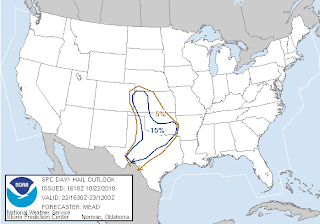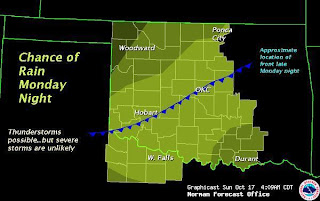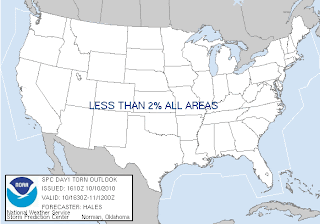SPC Day 1 Outlook. Slight risk over TX, OK, and KS.
There is just something about the last chase of the year. It motivates us to get out there and witness what mother nature can do. October 22 is probably our last chase for this year and it was well worth it. A strong midlevel jet was maxing out right over western north Texas during the peak heating hours. Strong curving in hodographs showed rotation in the lowest 0-6km of the atmosphere. Lingering precipitation/cloud cover limited sunshine and decreased instability. There were a few breaks in the clouds and thunderstorms fired up in western north Texas. I coordinated with James Langford and Zack Biggs to meet up in Wichita Falls and we chased together. It always nice when its a local "backyard" chase. It was an excellent chase, as we intercepted a few supercells. Check out the full report down below.
Thanks for the support.
-Ben
SPC Tornado graphic for Day 1. We had awesome shear with these storms, but due to the lack of instability and cold air constantly undercutting the updrafts we did not see any tornadoes.
SPC Hail graphic for Day 1.
SPC Wind graphic for Day 1.
Thunderstorms with explosive development over Knox and Haskell counties. Note how I am back in Wichita Falls. I was waiting for James and Zack to arrive.
Tornado watch issued for target area.
I meet up with James and Zack and we get out of Wichita Falls on Highway US 277 S and turn on Highway 25 to head north towards Electra, TX. Both storms have a hook appearance to them.
So our northern cell begins to wither away and the southern cell explodes (this is what happens during the entire chase) our next goal is to go back out of Mankins, TX, hook back up on 277, then go north on 183. Luckily the storms were moving at reasonable speeds and we blast our way on 183 to intercept.
Radar image as we turn on 183. The storm is intensifying and is maintaining the hook appearance.
On our way north on 183. You can see the mesocyclone/wall cloud as well as a beaver tail going into the storm.
Still driving on 183 the storm starts to look better and better. Its around this time that we actually witness a few possible funnels (one of which I captured on video).
We find a nice place to pull over and watch as the storm puts on a show for us.
This storm had some great structure on it.
So our main storm starts to dies out and a new cell develops just to our west. The lowering on this storm, while impressive looking, was not rotating. The cell to our southwest starts to become the more dominant storm. We leave 183 and head back on 277 to get in position for the storm.
We are in an excellent spot for some photography. No power lines or nothing.
More great structure on this storm.
This is a capture of the storms anvil (left portion of the photo). You can see the edges a very sharp. This updraft was moving some serious air!
This storm's wall cloud was rotating albeit fairly slow, it did have some incredible rising motion in it, however.
Radar image of our location in position to the storm.
The storms updraft base passes just to our northeast and shortly after the RFD.
The storm is occluding and we need to get to the northeast.
What? The TIV II out on a chase in October? We were actually quite surprised that there were some many chasers out on this storm. We expected everyone to target the triple point in western KS.
We had back east on 277 and watch as this storm occludes itself. But to our surprise another cell forms the south and actually doesn't look bad--visually.
New supercell to our southwest.
The storm is starting to approach us...
Incredible sunset with some awesome colors!
What is left of our northern cell is bathed in the pinkish light from the sunset.
It was just a great chase. We saw a few supercells, met some other chasers, and got some great photos. I would call it a success. To see more from this chase watch the video down below.






























































